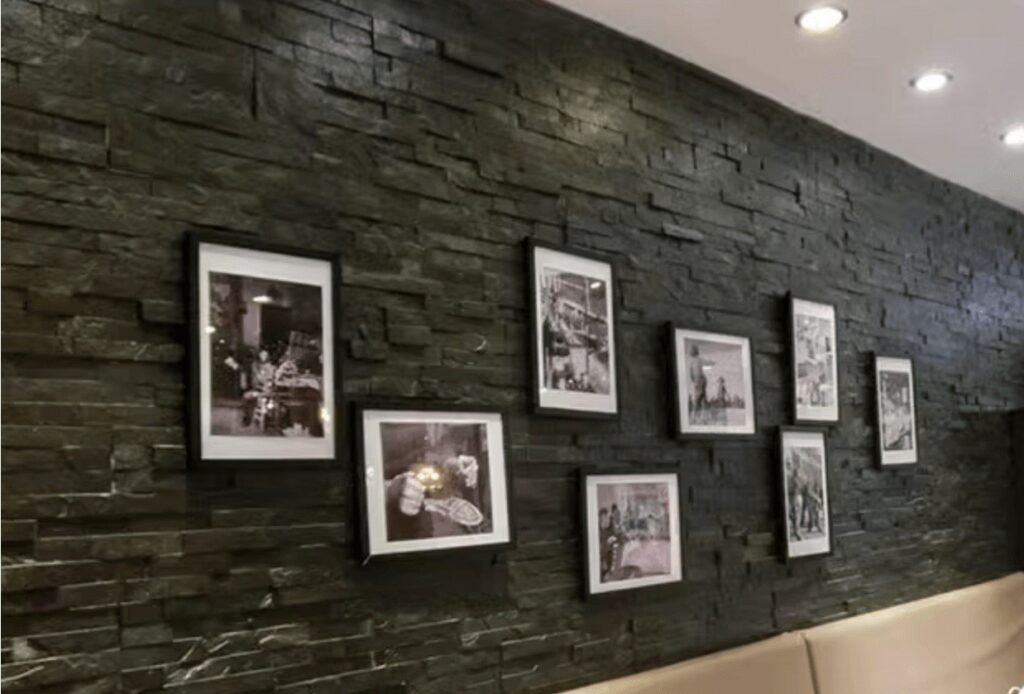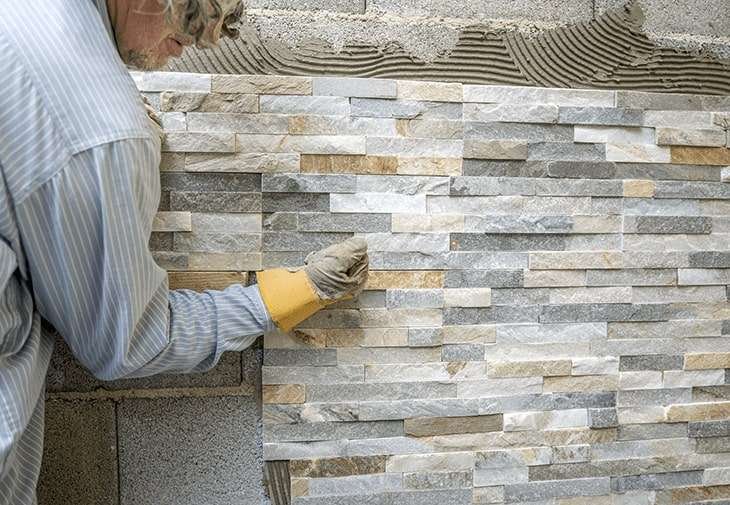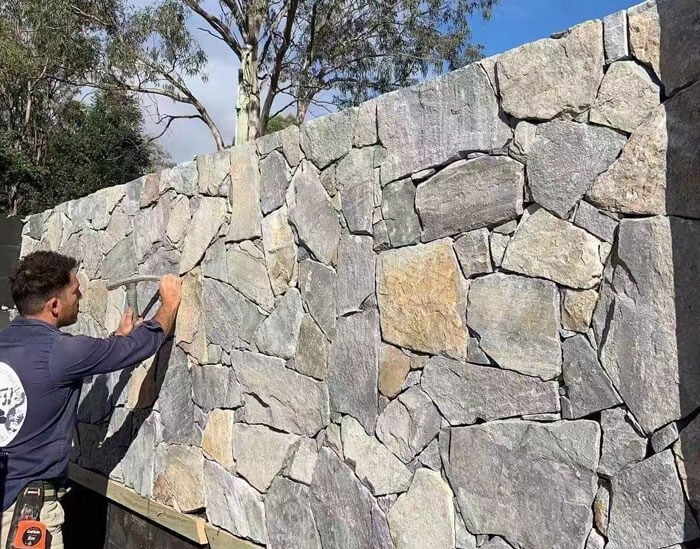Sei stanco di vedere la tua bella pannelli in pietra impilati perdere la loro lucentezza? Una delle più grandi frustrazioni per i proprietari di case è l'accumulo graduale di sporcizia, macchie e depositi minerali che diminuiscono il fascino naturale delle superfici di pietra.
Una corretta manutenzione è la chiave per preservare la bellezza e la longevità dei pannelli in pietra in pietra impilati. Questa guida fornisce strategie essenziali per la pulizia, la sigillatura e la protezione degli investimenti, garantendo che rimangano sbalorditivi per anni. Con oltre 15 anni di esperienza, l'ardesia di alto livello comprende quanto sia cruciale un'assistenza adeguata a mantenere l'integrità di Pietra naturale. Ci immergiamo su come mantenere la tua impiallacciatura in pietra che sembra al meglio.
4 Steps to Prep for Stacked Stone Veneer Panel Maintenance
Maintaining pannelli in pietra impilati ensures they remain beautiful and durable for years. Proper preparation is key to effective maintenance, setting the stage for cleaning, sealing, and protecting your investment. Let’s dive into the essential steps to get you ready. You’ll want to take care to protect and preserve that investment!
“Effective preparation for stone veneer maintenance ensures longevity and aesthetic appeal, saving homeowners time and money in the long run.”
Assessing Your Stacked Stone Veneer: Identifying Stone Type and Condition
Start by carefully inspecting your pannelli in pietra impilati. Identify the type of stone (slate, quartzite, etc.) as different stones require different cleaning and sealing methods. Look for signs of damage such as cracks, chips, or discoloration. Note any areas with moss, algae, or mineral deposits. Understanding the condition of your veneer helps you choose the appropriate maintenance strategy. This detailed assessment is the first step in ensuring a successful maintenance process.
Gathering the Right Tools and Materials: A Comprehensive Checklist
Having the right tools and materials is crucial for efficient stone veneer maintenance. Here’s a checklist to get you started: Soft-bristled brushes, pH-neutral cleaner, garden hose with adjustable nozzle, sealant (appropriate for your stone type), sealant applicator, safety glasses, gloves, and a bucket. For tougher stains, you might need a specialized stone cleaner. Make sure all products are compatible with your specific type of stone to avoid damage. Investing in quality tools ensures the job is done right the first time.
Safety Precautions: Protecting Yourself and the Surrounding Area
Safety should always be your top priority. Wear safety glasses and gloves to protect yourself from chemicals and debris. Cover any nearby plants or surfaces that could be damaged by cleaning or sealing products. Ensure proper ventilation when working with sealants or cleaners. If using a pressure washer, start with a low setting to avoid damaging the stone. Always read and follow the manufacturer’s instructions for all products. A little precaution goes a long way in preventing accidents and injuries.
Understanding Environmental Factors: How Climate Affects Maintenance Needs
Climate plays a significant role in the maintenance needs of your pannelli in pietra impilati. In areas with frequent rain or snow, consider applying a water-repellent sealant to prevent water damage. Hot, sunny climates may cause fading, so choose a UV-resistant sealant. Coastal environments require sealants that protect against salt damage. Regular inspections are especially important in harsh climates to identify and address issues early. Understanding your local climate helps tailor your maintenance approach for optimal results. Over 15 years, Top Source Slate has observed that in regions with harsh winters, annual sealing is crucial to prevent freeze-thaw damage.
Coco from Top Source Slate always says, “Consistent maintenance is key to extending the life of your pannelli in pietra impilati. Skipping steps can be a real ride-or-die situation for your wallet. Doing it right saves money and keeps things looking great!”
By properly assessing, preparing, and understanding the environmental factors, you set the foundation for successful rivestimento in pietra accatastato maintenance. With the right approach, your stone veneer will continue to enhance the beauty and value of your property for years to come. These preliminary steps are not just about cleaning; they’re about preserving the integrity and beauty of your investment.
Stone Veneer Maintenance Schedule
| Compito | Frequenza | Strumenti/materiali | Note | Industry Benchmark |
|---|---|---|---|---|
| Ispezione | Mensile | Occhi | Check for cracks, discoloration, or damage | Trimestrale |
| Pulizia | 6 Months | Soft brush, pH-neutral cleaner | Remove dirt, moss, and algae | Annualmente |
| Sigillatura | 1-3 Years | Stone sealant, applicator | Apply sealant to protect from water and UV damage | 2-4 anni |
| Repair | Secondo necessità | Mortar, patching compound | Fix cracks or chips promptly | N / A |
| Professional Inspection | 3-5 anni | N / A | Comprehensive assessment by a stone specialist | 5 Years |
Step-by-Step Guide to Cleaning Stacked Stone Veneer Panels
Pulizia pannelli in pietra impilati is essential for maintaining their beauty and longevity. This guide provides a detailed, actionable approach to safely and effectively clean your stone veneer, addressing both routine maintenance and stain removal. From gentle techniques to tackling tough stains, we’ve got you covered. Proper cleaning will keep your stone looking its best!
Regular cleaning of stacked stone care significantly extends the life and aesthetic appeal of stone veneer, preventing costly repairs.
Gentle Cleaning Techniques: Soft Brushing and Mild Detergents
For routine cleaning of your pannelli in pietra impilati, start with gentle techniques. Use a soft-bristled brush and a pH-neutral cleaner diluted in water. Gently scrub the surface to remove dirt and debris. Avoid using abrasive brushes or harsh chemicals, as they can damage the stone. Rinse thoroughly with clean water from a garden hose with a gentle spray nozzle. This method is ideal for removing everyday dust and grime without harming the veneer. Remember, gentle is the key!
Removing Common Stains: Addressing Efflorescence, Mold, and Algae
Different stains require different approaches. Efflorescence (white salt deposits) can be removed with a specialized efflorescence cleaner or a diluted vinegar solution. For mold and algae, use a mold and mildew remover specifically designed for stone. Apply the cleaner, let it sit for the recommended time, and then gently scrub and rinse. Always test the cleaner in an inconspicuous area first to ensure it doesn’t discolor the stone. Addressing stains promptly prevents them from becoming permanent.
DIY Cleaning Solutions vs. Professional Cleaners: Pros and Cons
DIY cleaning solutions like diluted vinegar or baking soda can be effective for light cleaning, but they may not be strong enough for tougher stains. Professional stone cleaners are formulated to be safe and effective on stone surfaces, but they can be more expensive. Consider the severity of the stains and the type of stone before choosing a cleaning solution. For valuable stone veneer maintenance, professional cleaners often offer a safer and more effective option, but always follow the product instructions carefully. It’s all about finding the right balance!
Preventing Damage During Cleaning: Avoiding Harsh Chemicals and Abrasive Tools
Prevention is better than cure. Avoid using harsh chemicals like bleach, ammonia, or acidic cleaners, as they can damage the stone. Never use abrasive tools like wire brushes or scouring pads. Always test any cleaning solution in an inconspicuous area before applying it to the entire surface. Rinse thoroughly after cleaning to remove any residue. Proper cleaning techniques preserve the beauty and integrity of your pannelli in pietra impilati. Remember, gentle care extends the life of your investment.
Coco from Top Source Slate says, “Proper cleaning is essential for maintaining stacked stone veneer panels. Regular maintenance prevents costly repairs and keeps your stone looking its best! Investing in the right products from the start can save you a pretty penny in the long run.”
In summary, cleaning stacked stone veneer panels involves gentle techniques, appropriate stain removal methods, and careful selection of cleaning solutions. By following these steps, you can effectively maintain the beauty and longevity of your stone veneer. Remember, a proactive approach to cleaning ensures your stone remains an attractive feature of your home or building. This also helps in minimizing future maintenance costs.
| Soluzione detergente | Professionisti | Contro | Meglio per | Raccomandazione sull'ardesia di alto livello |
|---|---|---|---|---|
| pH-Neutral Cleaner | Safe for all stone types, gentle | May not remove tough stains | Routine cleaning | Brand X pH-Neutral Stone Cleaner |
| Vinegar Solution (Diluted) | DIY, inexpensive | Can be too acidic for some stones | Efflorescence | Test on inconspicuous area first |
| Mold & Mildew Remover (Stone-Specific) | Effective for mold and algae | May contain harsh chemicals | Mold and algae removal | Brand Y Stone Mold Remover |
| Efflorescence Cleaner | Specifically targets salt deposits | Can be expensive | Efflorescence removal | Brand Z Efflorescence Cleaner |
| Baking Soda Paste | DIY, mild abrasive | May not remove all stains | Light stain removal | Mix with water to form a paste |
Foca & Protect Stacked Stone Veneer: Maximize Longevity
Sealing and weatherproofing are critical steps to extend the lifespan and maintain the aesthetic appeal of pannelli in pietra impilati. This chapter educates readers on the importance of these processes, focusing on product selection and application techniques. Proper sealing ensures your investment remains beautiful for years. Let’s keep that stone looking great!
Properly sealing pannelli in pietra impilati extends their lifespan, protects against damage, and maintains their aesthetic appeal, providing long-term value.
The Importance of Sealing: Preventing Water Damage and Stains
Sigillatura pannelli in pietra impilati is vital for preventing water damage and stains. Unsealed stone is porous, allowing water to penetrate, which can lead to cracks, discoloration, and the growth of mold or mildew. Sealing creates a protective barrier, preventing water and other contaminants from entering the stone. This not only preserves the stone’s appearance but also its structural integrity. Consider sealing as a shield for your veneer.
Types of Sealants: Choosing the Right Product for Your Stone
Choosing the right sealant is crucial. Options include penetrating sealants, which soak into the stone and provide invisible protection, and membrane-forming sealants, which create a protective layer on the surface. The best choice depends on the type of stone and the desired finish. For example, slate benefits from penetrating sealants that enhance its natural color, while other stones may require membrane-forming sealants for added protection. Always read product labels and consult with a stone care professional. Matching the sealant to the stone is key!
Application Techniques: Ensuring Proper Coverage and Penetration
Proper application is essential for effective sealing. Clean the stone thoroughly before applying the sealant. Use a brush, roller, or sprayer to apply an even coat. Allow the sealant to penetrate the stone according to the manufacturer’s instructions. Apply a second coat if necessary, especially in high-moisture areas. Avoid applying sealant in direct sunlight or during extreme temperatures. Ensure proper ventilation during application. Follow the instructions for best results! It’s all about evenness and saturation.
Weatherproofing Strategies: Protecting Against Freezing Temperatures and UV Exposure
Weatherproofing protects against freezing temperatures and UV exposure. In cold climates, water trapped inside the stone can freeze and cause cracks. Use a water-repellent sealant to prevent water penetration. In sunny climates, UV exposure can cause fading and discoloration. Choose a UV-resistant sealant to protect against these effects. Regular inspections and resealing are necessary to maintain weatherproofing. A good sealant is your veneer’s best defense.
Coco from Top Source Slate emphasizes: “Sealing is non-negotiable for long-lasting Pietra naturale durability. Neglecting this step is like skipping sunscreen at the beach – you’re just asking for trouble!”
In conclusion, sealing and weatherproofing are critical steps for extending the life and beauty of your pannelli in pietra impilati. By understanding the importance of sealing, choosing the right sealant, applying it properly, and implementing weatherproofing strategies, you can ensure your stone veneer remains stunning for years. This effort reduces long-term costs by minimizing repairs and replacements. A little sealant goes a long way.
| Tipo di sigillante | Professionisti | Contro | Best Use | Durata |
|---|---|---|---|---|
| Penetrating Sealant | Invisible, allows stone to breathe | May not provide as much surface protection | Slate, porous stones | 1-3 years |
| Membrane-Forming Sealant | Excellent surface protection | Can alter the stone’s appearance | High-traffic areas, added protection | 3-5 anni |
| Water-Repellent Sealant | Prevents water penetration | May require more frequent reapplication | Cold climates | 1-2 anni |
| UV-Resistant Sealant | Protects against fading | May be more expensive | Sunny climates | 2-4 anni |
| Silicone-Based Sealant | Flexible, good for expansion joints | Can be difficult to apply evenly | Expansion joints, flexible sealing | 5-10 anni |

Conclusione
From my years in the stacked stone industry, I’ve seen firsthand how a little care goes a long way. Cleaning and sealing your stone veneer isn’t just about aesthetics; it’s about protecting your investment and preventing headaches down the road.
A Top Source Slate, sottolineiamo sempre l'importanza della manutenzione proattiva. È più economico prevenire danni che risolverlo e un'impiallacciatura di pietra ben mantenuta può davvero migliorare la bellezza e il valore della tua proprietà. Pensa a come dare alla tua pietra un bagliore.
So, take the time to clean, seal, and protect your pietra accatastata. You’ll not only enjoy its beauty for years to come, but you’ll also save yourself money and stress in the long run. And if you ever need advice or high-quality stone products, you know where to find me!
FAQ
Q1: How do you clean stacked stone veneer panels?
A1: Use a soft-bristled brush with warm water and a mild detergent, like dish soap, to gently scrub away dirt. Avoid harsh chemicals, bleach, or acidic cleaners that can damage the stone. Rinse thoroughly with a garden hose and let it dry completely.
Q2: What is the best sealant for stacked stone veneer panels?
A2: A penetrating, water-based sealant, such as silane or siloxane-based products, is ideal. These sealants protect without altering the stone’s appearance and allow it to breathe, ensuring longevity.
Q3: How often should you seal stacked stone veneer panels?
A3: Seal every 1-3 years, depending on exposure to weather and the sealant’s specifications. Check the manufacturer’s guidelines, as porous stones like sandstone may need more frequent sealing.
Q4: Can you pressure wash stacked stone veneer panels?
A4: No, pressure washing is not recommended. High pressure can erode the surface, damage pigmentation, and reduce durability. Use a gentle hose rinse instead.
Q5: How do you maintain stacked stone veneer outdoors?
A5: Regularly inspect for cracks or loose stones, clean with mild soap and water, and apply a sealant every few years. Ensure proper drainage to prevent moisture buildup behind the panels.
Q6: Does stacked stone veneer need to be sealed?
A6: Sealing is optional but recommended, especially for exterior use. It protects against moisture, stains, and fading, enhancing longevity, though some manufacturers say it’s not required.
Q7: How do you remove stains from stacked stone veneer panels?
A7: For light stains, use a soft sponge with water and mild detergent. For tougher stains like rust, apply a stone-safe cleaner (avoid acids) and rinse immediately. Always test on a small area first.
Q8: What affects the longevity of stacked stone veneer panels?
A8: Quality of materials, proper installation, regular maintenance, and sealing impact longevity. Harsh weather and poor drainage can shorten its lifespan if not addressed.
Collegamenti esterni
- Maintenance for Exterior Stacked Stone Ledger Panels – Superfici MSI
- Sealing Natural Stone Veneer – Norstone USA
- Stone Veneer Longevity: What Homeowners Need To Know – Fix My Brick
- Stone Sealing and Waterproofing – Southern Stain and Seal
- Should I Seal My Stone Veneers? – Sherwood Lumber
- How To Clean Natural Stone Veneers – Erth Coverings
- Cleaning Rust From Stacked Stone Veneer – Norstone USA
- Stone Veneer Maintenance – Casa Di Sassi


